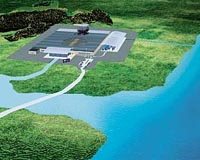 |
Washington DC (SPX) Nov 27, 2009 A team of researchers at the Massachusetts Institute of Technology has developed a new modeling methodology for determining the capacity and assessing the risks of leakage of potential underground carbon-dioxide reservoirs. One strategy for mitigating greenhouse gases is to inject compressed carbon dioxide into natural aquifers made of permeable rock soaked with brackish salt water. Carbon dioxide is less viscous and less dense than the water, and, once injected, it rises to the top of the aquifer. The permeable rock usually lies underneath a dense, impermeable "cap rock," that traps the gas deep underground for long periods of time. Cap rocks are often tilted, however, and as the carbon dioxide rises through the aquifer, it can slip out, eventually making its way back into the atmosphere. Engineers seek to avoid leakage by mapping potential reservoirs and using theoretical tools to predict carbon dioxide flow. Now doctoral students Christopher MacMinn and Michael Szulczewski and Professor Ruben Juanes of the Massachusetts Institute of Technology have developed a new modeling methodology for determining the capacity of potential reservoirs and for assessing the risks of leakage. The tool takes into account key aspects of the underlying physics to predict the shape and pattern of flow when carbon dioxide is injected into a deep underground aquifer. "Our new modeling tool is analytical rather than numerical, which means it incorporates the three primary physical mechanisms by which carbon dioxide is trapped in briny substrate - structural, capillary and dissolution trapping - into a single, comprehensive mathematical expression that can be solved quickly," says MacMinn. "This makes it possible for us to alter key parameters, such as the aquifer permeability, the fluid viscosities or the tilt of the cap rock, and within seconds, predict how the plume of carbon dioxide will migrate through the subsurface." Before, each parameter change in a numerical model added hours or days to the time it took a computer to model discrete sections of the substrate and pull all these together into a prediction of carbon dioxide behavior under those limited circumstances. Engineers would have needed to run dozens if not hundreds of these to incorporate all the likely parameter permutations, making this an infeasible means of assessment. The hope now is that engineers and geologists may be able to use this new modeling tool to quickly and inexpensively determine whether carbon dioxide would escape from a geological reservoir. Share This Article With Planet Earth
Related Links American Institute of Physics Powering The World in the 21st Century at Energy-Daily.com
 Norway opens first osmotic power plant
Norway opens first osmotic power plantTofte, Norway (UPI) Nov 24, 2009 A Norwegian power company announced Tuesday Norway's Crown Princess Mette-Marit will head the opening of the world's first osmotic power plant. Statkraft, Europe's largest renewable energy company, said the plant at Tofte, outside Oslo, will generate power by using the energy produced when fresh water and seawater are mixed, the Norway Post reported. Osmotic power is an emissions ... read more |
|
| The content herein, unless otherwise known to be public domain, are Copyright 1995-2009 - SpaceDaily. AFP and UPI Wire Stories are copyright Agence France-Presse and United Press International. ESA Portal Reports are copyright European Space Agency. All NASA sourced material is public domain. Additional copyrights may apply in whole or part to other bona fide parties. Advertising does not imply endorsement,agreement or approval of any opinions, statements or information provided by SpaceDaily on any Web page published or hosted by SpaceDaily. Privacy Statement |